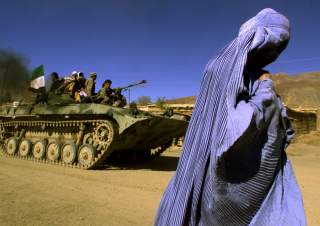America Can't Solve Afghanistan's Corruption Problems
Washington tried to remake Kabul for eighteen years, but it is time to acknowledge the limits of U.S. power and to come home.
On Monday, April 8, three U.S. soldiers and one contractor were killed by a roadside bomb in Afghanistan, bringing the total number of U.S. personnel killed there in 2019 to seven. For advocates of foreign policy restraint, every new American death represents the moral imperative for U.S. withdrawal from the region. To the Trump administration’s credit, U.S. envoys have been in discussions with the Taliban for months, seeking a possible end to the now almost eighteen-year-old war. But these efforts have been met largely with derision inside the D.C. Beltway. Representatives Jim Banks and Liz Cheney went so far as to introduce the “Ensuring a Secure Afghanistan Act” last week, to prevent a possible drawdown in Afghanistan if they are not satisfied with the details of any U.S.-Taliban deal.
It is true that without U.S. support, Afghanistan would crumble, and, most likely, crumble fast. But as the latest report from the Special Inspector General for Afghanistan Reconstruction (SIGAR) shows clearly, Washington’s nation-building project has failed. Nearly two decades of American investment has produced no enduring progress and in some cases—such as corruption—actually made things worse. More money, time, and precious life will not produce a secure and stable Afghanistan. The best path for the United States is to leave, ending the facade of state-building, and focusing solely on counterterrorism.
According to SIGAR, the three most pressing threats in Afghanistan, as cataloged in their recent 2019 High Risk list, are widespread insecurity, endemic corruption, and an underdeveloped civil policing capability. The Afghan military is “constrained by capability challenges and depend on donor support . . . to fund their sustainment, equipment, infrastructure, and training costs.” Additionally, corruption and “threats to the rule of law persist despite anticorruption efforts by the Afghan government and donor nations.” Moreover, the U.S. Defense Department maintains that “corruption remains the top strategic threat to the legitimacy and success of the Afghan government.” Yet current Afghan police “sustainment costs are well beyond the Afghan government’s ability to fund and will require continued foreign assistance well into the future.”
Compare this to the inaugural High Risk list compiled in 2014. Major threats then also included corruption and sustainability—“[m]uch of the . . . $104 billion the United States has committed to reconstruction projects and programs risks being wasted because the Afghans cannot sustain the investment without massive continued donor support.” In fact, that list warned that the Afghan government lacked the ability to provide for its own security. So, in other words, not much has changed in five years.
How much more does the United States have to invest before American policymakers realize this is a losing game? Take the corruption issue. Corruption is the state’s Achilles heel. It alienates the population, eliminates the possibility of a real rule of law, and deprives the state of revenue and credibility. SIGAR says that if corruption remains a problem in Afghanistan, “U.S. reconstruction programs, at best, will continue to be subverted . . . and, at worst, will fail.” And that’s exactly what SIGAR finds again and again: “Despite many anticorruption efforts, the problem persists.”
Specifically, the “Afghan government is still slow to prosecute corruption cases and has a poor record of prosecuting powerful and influential actors.” Their anti-corruption efforts don’t “meet international standards and best practices,” and their “goals are not fully aligned with the benchmarks set to measure progress toward implementation, complicating assessments of progress toward the goals.” They only meet self-imposed benchmarks after SIGAR sends them an assessment of their efforts.
The irony is that America helped create this problem in the first place. In 2001, Washington kicked the Taliban out and installed a client state with the promise of billions of dollars in international money. As SIGAR’s 2014 High Risk report noted, “[m]assive military and aid spending overwhelmed the Afghan government’s ability to absorb it. This, coupled with weak oversight, created opportunities for corruption.”
This failure was inevitable. When a poor country with low state capacity all of a sudden finds itself rife with cash, the risk of waste, fraud, and abuse will be dramatically increased. Both traditional Afghan power players, as well as previously non-influential individuals, were able to exploit this atmosphere to advance their own political and economic goals. Considering this, it’s hard to take seriously the argument that what Afghanistan needs is more time and money.
U.S. envoys are currently in talks with the Taliban, attempting to facilitate an intra-Afghan dialogue that could lead to a ceasefire. This has led to criticism of the Trump administration, some of which correctly points out that “meaningful peace talks between the Taliban and the Afghan government are not likely to happen,” and that we should not trust the Taliban.
But those facts don’t negate the argument for leaving. Nearly eighteen years of reconstruction and state-building efforts have failed. The logic of exit rests not on trust in the Taliban but on the threat of punishment. Even the most fervent advocates of restraint acknowledge that counterterrorism activities in the face of an imminent threat are justified. But that doesn’t mean America has to continue risking the lives of thousands of U.S. troops in the hopes of finding the magic formula for rebuilding Afghanistan.
Jerrod A. Laber is a Washington-based foreign-policy writer and a senior contributor for Young Voices. His work has appeared in Defense One, The Independent, the Columbus Dispatch, and The National Interest, among other outlets. Follow him on Twitter @JerrodALaber.
Image: Reuters

